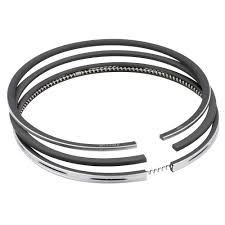What is a Piston Ring?
A piston ring is a metallic split ring that is attached to the outer diameter of a piston in an internal combustion engine or steam engine
The main functions of piston rings in engines are:
1.Sealing the combustion chamber so that there is minimal loss of gases to the crank case.
2.Improving heat transfer from the piston to the cylinder wall.
3.Maintaining the proper quantity of the oil between the piston and the cylinder wall
4.Regulating engine oil consumption by scraping oil from the cylinder walls back to the sump.
5.Piston ring packages are as carefully engineered as any high-performance part, but the “middle child” might be the most misunderstood. Here’s a look at the science that goes into second ring design.
Since the invention of the metal piston ring at the start of the industrial revolution (which, you could argue, finally made steam power impractical), there’s been constant innovation and improvement in cylinder sealing technology for these seemingly simple parts. The ring package has three primary goals: Keep pressure confined to the combustion chamber on both the compression and power strokes, transfer heat from the piston to the cylinder walls where it can be removed via air or liquid cooling, and control lubrication to limit oil consumption and unwanted emissions.
(The picture is from Landtop)
Piston rings are designed to seal the gap between the piston and the cylinder wall. If this gap were too small, thermal expansion of the piston could mean the piston seizes in the cylinder, causing serious damage to the engine. On the other hand, a large gap would cause insufficient sealing of the piston rings against the cylinder walls, resulting in excessive blow-by. (combustion gases entering the crankcase) and less pressure on the cylinder, reducing the power output of the engine.
The sliding motion of the piston ring inside the cylinder wall causes friction losses for the engine. The friction caused by piston rings is approximately 24% of the total mechanical friction losses for the engine. The design of the piston rings is therefore a compromise between minimising friction while achieving good sealing and an acceptable lifespan.
Lubrication of piston rings is difficult and has been a driving force to improvements in the quality of motor oil. The oil must survive high temperatures and harsh conditions with a high-speed sliding contact. Lubrication is particularly difficult as the rings have an oscillating motion rather than continuous rotation (such as in a bearing journal). At the limits of piston movement, the ring stops and reverses direction. This disrupts the normal oil wedge effect of a hydrodynamic bearing,reducing the effectiveness of the lubrication.
Rings are also sprung to increase the contact force and to maintain a close seal. The spring force is provided by either the stiffness of the ring itself or by a separate spring behind the seal ring.
It is important that rings float freely in their grooves within the piston, so that they can stay in contact with the cylinder. Rings binding in the piston, usually due to a build-up of either combustion products or a breakdown of the lubricating oil, can cause engine failure and is a common cause of failure for diesel engines.
While it’s easy to look at the top ring or the oil ring at the bottom and intuitively understand their contribution to meeting these objectives, the second ring is more of a mystery. What’s it supposed to be doing, and why is it necessary? How do the materials used and physical properties of the second ring affect performance? To answer these questions, we turned to Senior Technical Account Manager Alan Stevenson, the go-to source for knowledge about piston rings.


Comments
Post a Comment